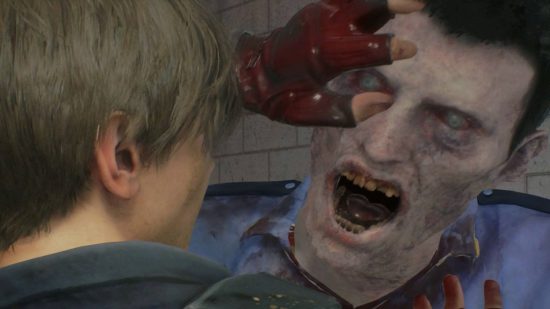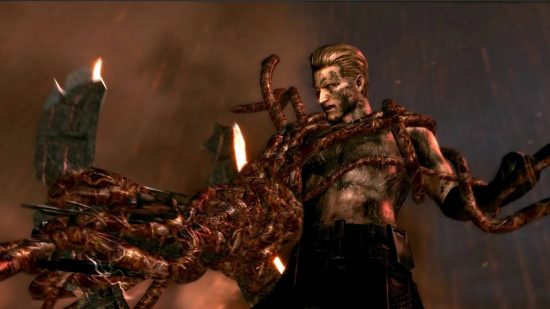The Resident Evil virus is intrinsic to the series, with different iterations and evolutions popping up in every single entry to help those pesky zombies squirm their way across our screens. Whether Wesker is cooking up the virus in a lab or a new form is infecting folks in a small village in Europe, the many different strands of the Resident Evil virus are a nuisance, and we’re explaining them all here.
Before we infect your brain with the knowledge from the rest of this guide, be sure to shamble like a zombie into the rest of our amazing Resident Evil content. We have articles covering Resident Evil Ashley, Resident Evil Village characters, Resident Evil Sherry, Resident Evil Sheva, Resident Evil 3 safe codes, Resident Evil Krauser, Resident Evil 2 safe codes, Resident Evil 4 Merchant, and much more.
What is the Resident Evil virus?
There’s not one singular Resident Evil virus. The t-virus is the first introduced and the most famous, as it’s responsible for many of the subsequent viruses that play a role in the series up to the modern day. Umbrella developed the t-virus from the progenitor virus, a possibly ancient virus that stems from Sonnentreppe daisies. Meanwhile, instead of viruses, some games introduce different concepts, like Resident Evil 4’s Las Plagas parasite.
Every Resident Evil virus
Progenitor virus
The progenitor virus is the basis for the t-virus and every subsequent strain. The series explains that Dr. Edward Ashford, Dr. James Marcus, and Lord Ozwell E. Spencer discovered it on December 4, 1967. While some wanted to use the virus’ healing abilities to help humanity, instead, the scientists warped it into a bioweapon.
T-virus
Otherwise known as the tyrant virus, the t-virus is the most prolific and recognizable of all the Resident Evil viruses. The t-virus causes the host to turn into a zombie and also creates the series’ iconic enemies, such as Resident Evil lickers and Resident Evil tyrants. It cannot reanimate the dead, but it can sustain a host near death, such as zombies with skin peeling off their flesh.
Learn more about two people constantly fighting the t-virus in our Resident Evil Chris and Resident Evil Jill guides.
G-virus
The g-virus, golgotha virus, or god virus, comes about from experiments that early Umbrella held in the 60s, as well as experiments on Liza Trevor. Much like the t-virus, it causes rapid mutation and aggressive behavior, but unlike others, the g-virus is capable of bringing already dead tissue back to life.
Perhaps the person best known for fighting it is Resident Evil Claire.
Uroboros
Experiments by Resident Evil’s Albert Wesker and Alex Wesker create the Uroborus virus, an extension of the t-virus that also uses Jill Valentine’s t-virus antibodies. It rejects most hosts, but the few that survive take on extraordinary strength and abilities. It features snaking black tendrils, and Albert Wesker infects himself with it in Resident Evil 5.
C-virus
Resident Evil 6 introduces the c-virus, or chrysalid virus, another extension of the t-virus that can reanimate dead tissue, much like the g-virus. Many enemies in Resident Evil 6 infected with it exhibit violent behavior and large monstrous mutations, though it seems less consistent than previous viruses. Whether this is down to the narrative or Resident Evil 6 itself, we don’t know.
Las plagas parasite
Resident Evil 4 swaps out viruses for a different kind of infection, as the Ganados of the series’ fourth entry are instead hosts to Las Plagas, a deadly parasite that takes over the host’s body. Las Plagas infects both humans and animals but acts of its own will, instead of increasing the violent behavior of the host. It also shoots out long tentacles and limbs, warping the host’s flesh into stingers, scythes, and other weapons.
Get to know the Las plagas parasite with our Resident Evil 4 Switch guide.
Megamycete, mold, and cadou parasite
The final entry on the list, Resident Evil 7 introduces the megamycete concept, a black goo of ancient origin and fungal in nature. Also known as the mold, the megamycete can infect other creatures, it also seems entirely capable of taking on a form such as the molded from Resident Evil 7’s basement.
Later in Resident Evil Village Mother Miranda experiments with the substance called the mold with comes from the megamycete, creating the cadou parasite, and this is responsible for the many infected villagers and monstrous creatures found in Resident Evil Village.

Alright, that’s all we have on the many Resident Evil virus for today. We hope that is the cure for your burning virus questions, but if you need even more Resi content, then be sure to read our Resident Evil characters and Resident Evil 2 characters guides next.















